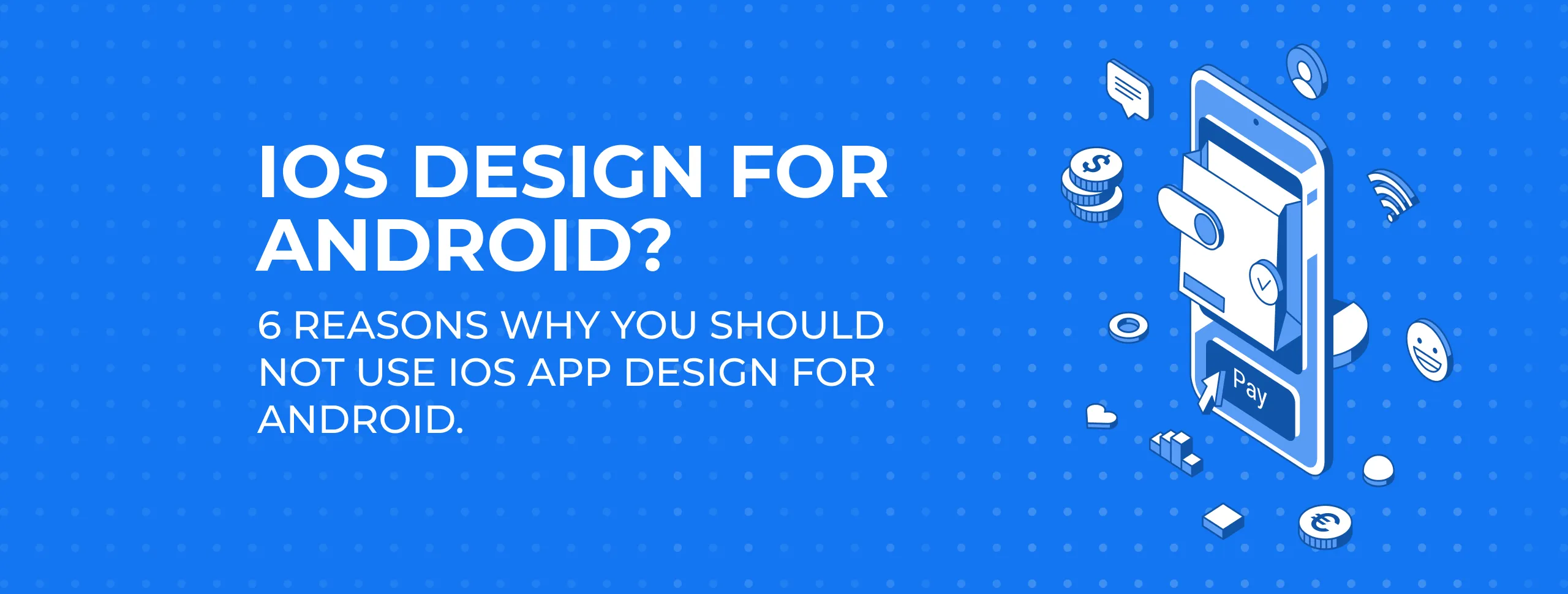
iOS Design for Android? 6 Reasons why you SHOULD NOT Use iOS App Design for Android.

A lot of our customers are interested in porting their existing iPhone apps to Android.
Oftentimes, they neglect the importance of native Android design. We’ve put together some compelling arguments why you should NOT use iOS UI design for your Android app.
Foreword
“Kirill, I’ve dropped an email, can you make an estimation?” – a lot of projects start off like this at Magora. Before getting down to work, I make a careful estimation of the time needed to implement an Android-project. This estimation serves as a guideline for a customer, helps him shape some idea of how much money and time the project will require. So I look through his written specification, where he explicitly describes the idea of his app, and when I get to the point where I see the design… Bummer! I enter into an interesting conversation:
-But that’s an iOS design, where do I get User Interface design for Android? -There is none. Develop the Android app with the iOS design. *a deep, desperate sigh*
Why is that bad?
Here could have been a great deluge of my thoughts. I could have described the styles of different systems, cited style-guides (documents that specify how to develop applications for different platforms), carried out a comparative analysis of Android and iOS components. But I won’t. Let me do it smarter and show you a couple of simple examples.
Case 1. Jigsaw puzzle
Just imagine, you’ve ordered two cool jigsaw puzzles in a local internet-store. So you get two giant boxes with exquisite paintings on them, and they are luring you into doing the puzzle. You pick one and start putting the pieces together. Eventually, after you killed the whole week on the first jigsaw puzzle, you can’t take your eyes off a brilliant masterpiece. Now let’s get down to the second puzzle. In the process of work you realize that some of the details are missing. It seems you have lost them. You don’t want to order the missing details, because you have already spent a decent amount of money. Not a problem! Let’s take out some similar looking pieces from the jigsaw puzzle No.1 and stick them into the jigsaw puzzle No.2. Don’t fit? Not a big deal! Why not use a hammer?
Case 2. House
Setting: An office of a small construction company that builds private cottages. A customer and a contractor are sitting at the table discussing a project: -Hello. -Good afternoon. -I've already ordered construction services from your company. You’ve done a good job and I’m willing to continue to work with you. -Thank you! I’m familiar with that project, we have built a wonderful house of Angara pinewood. A true Russian house where a Russian heart belongs. -Yes, it is. Now I want to order the exact same house, but made of brick. -Excellent, our specialists will adapt your old design to the new material and location, we will find the best products and the best workers with more than 10 years construction experience. -No, you don't understand. I don’t want you to adapt anything. I want my new brick house to look exactly the same as the wooden one. I want a wooden house made of brick. -Wooden house of brick? But brick and wood are two different materials, you know that, right? They differ in color, form, texture. Therefore, they will look differently. -Are you pulling my leg, really? That is a house, and this is a house. There is no difference what they are made of. -Sure, there is. See, they have opposite ... -Let’s put an end to this conversation! Are you a professional? So you either agree to prove your expertise and build a wooden house of brick, or I will find a more competent contractor. -Yes, of course we can. Bob, here's a project for estimation and design. Yes, we are building of brick. Design? No, there’s a design only for a wooden house. And the house should look exactly as if it was made of wood.
What is the lesson to learn?
Basically, the applications are also built of building materials. Different platforms require different components, varying in form, color, function and use. The ways those components are put together are not identical, either. Therefore, one and the same app will undoubtedly look different on different platforms.
Why is this happening?
Why are we taking orders to implement an Android app from iOS designs? There are multiple reasons for this sad phenomenon, let’s see what they are. 1. No money. You can have a vivid imagination, a deluge of ideas, a great verve, but very limited budget. So, on the one hand, a smart decision will be to save money on design work. To have one design across several platforms. In the worst case scenario, you are a mediator and are looking for cheaper solution with an outsourced team of developers, but your client has fixed budget expectations. Apparently, there is no money to hire a designer. 2. No need for Android design. Usually the clients say, "I already have an iOS app, port it to Android. Design? Well, why don’t you take the iOS design and do something similar? Or even better." Another popular case: “ See this website design? Use it for my Android app.” In general, this set of reasons is very similar to the first point. 3. One design to rule the world. A typical wishful thinking may sound like this: "Millions of my future users will certainly find it convenient, if all versions of my app have the same interface." 4. Android - liberty, equality , fraternity. If your application doesn’t conform to the official Style Guide, it will not be published on the AppStore. In Google Play, there is no such policy. Therefore, designers are sometimes footloose, and customers don’t care. Only Android users cry buckets when they see another designer’s “masterpiece". These are down-to-earth reasons that push people to stick to iOS design when porting the apps to Android. Now let's see what the consequences are.
Why is iOS design bad for Android?
-
There are no ‘helpful elves’. If you don’t hire a designer, someone will have to do the job for him. In this case, this will be an Android developer. So what’s the outcome? The Android developer’s reasoning sounds like this: “Ok, this element resembles the one we have on Android. And what is this? What if I replace this element with a similar-looking Android element, will this be ok? And what will the customer say? Dump me?” As we see, no work done by a designer means double work done by a programmer. Naturally, a programmer isn’t as skilled as a designer, so the quality of the job done might be dubious for a customer.
-
I repeat: there are no 'helpful elves'. This scenario is similar to the first one, but a little aggravated. In this case, a programmer doesn’t have any mobile design and has to make it up. This multiplies his work time and the outcome will be really distressing.
-
The road to hell is paved with good intentions. This proverb unequivocally speaks for itself in this case. At first, the idea to have one and the same design seems brilliant, because there is a small percentage of people, who opts to shift to Android after iOS. Here comes an excerpt from their internal debate: “Go to hell, iOS, you’ve screwed up my life with your jail-like policy. I’m breaking up with you! Android is my true love now. It has all of my favorite card games and allows downloading non-market apps.” So a newly converted Android user downloads that application and - OOPS! What does he see? The same old interface…Our hero is standing alone in his desperate thoughts, eyes watering. Curtain falls. “So why is that a bad thing?”, you want to ask. Indeed, 0,001 % of former iOS users can find the identical interface very handy. But on the other hand, the interface will never be the same. Remember building materials? They are different. So for the remaining 99,999 % the application will look and feel strange.
-
Big Brother doesn’t approve of it. Any Android application with iOS-like design has fewer chances of being promoted to the top of Google Play lists. For instance, the category “Editor’s choice” consists only of the apps, which are built in accordance with Android style guides. Obviously, Google Play top is the fastest way for your users to find you. In fact, this is crucial. However ingenious, ground-breaking or amazing your application is, no one will download it if they don’t know about it.
Conclusion
Let’s sum up. If you plan to create an Android app using iOS design, don’t expect to cut down on your costs. Most likely, your budget will double. Moreover, the look&feel of your app will leave much to be desired. Your users will be bitterly disappointed with a strange interface and behavior, because it’s not what they’re so used to. What crowns it all, The Google Play reviewers will never give your app a positive rating, and consequently, your app will never be featured in the top results. Now, do you really want a wooden house built of brick? Find out about our design services.





